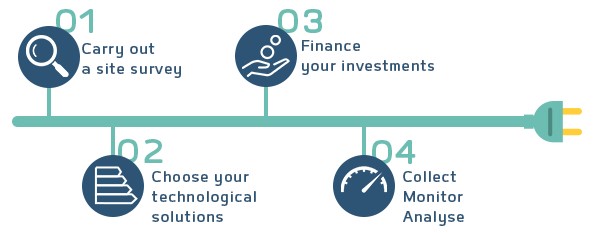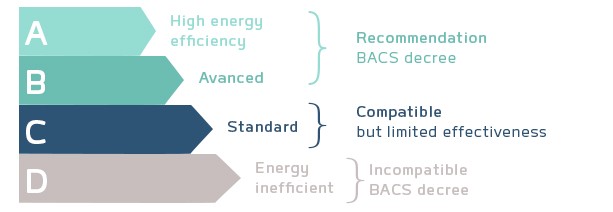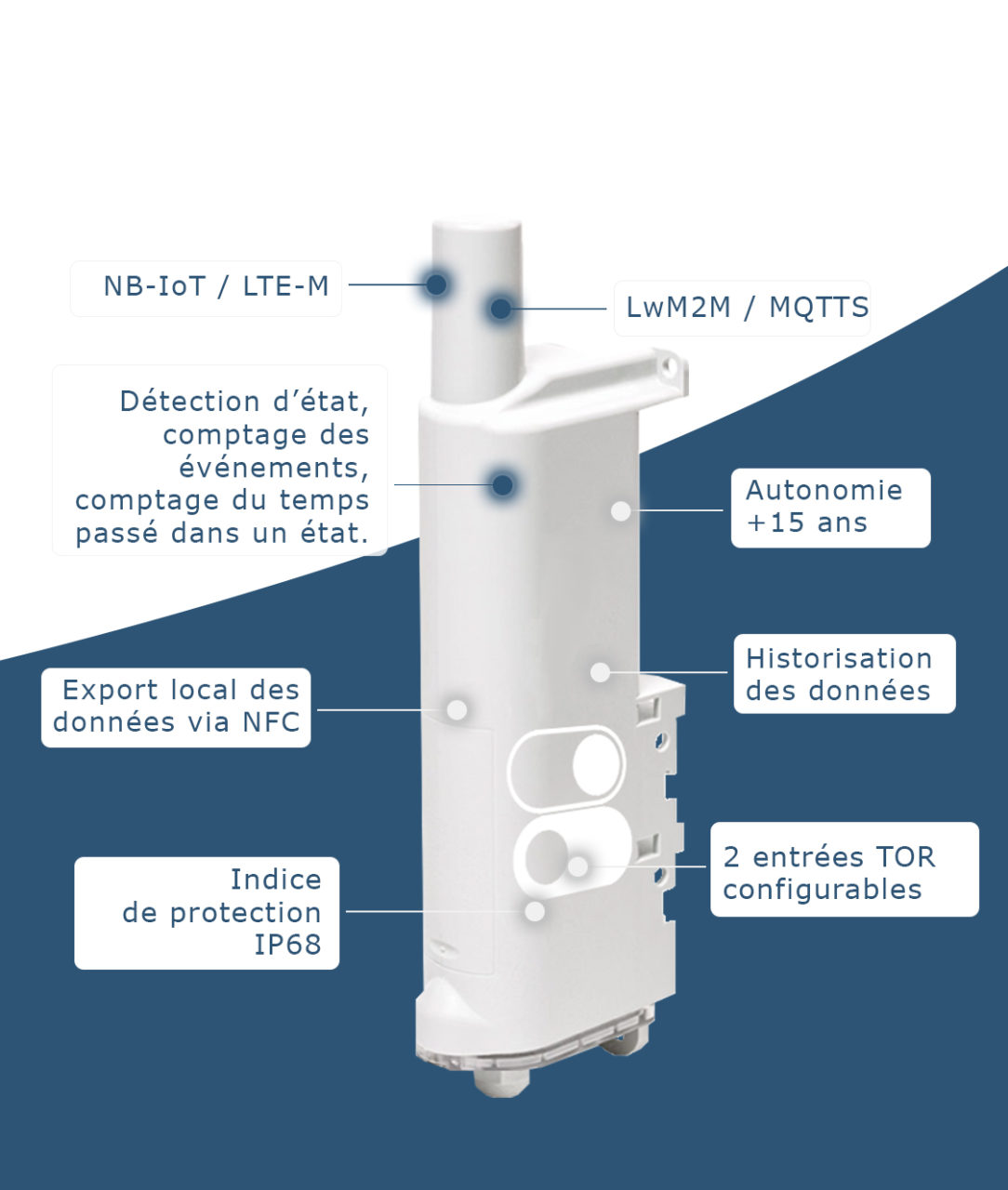The landscape of buildings is undergoing a major change with the advent of the “Decret Tertiaire”, which imposes a gradual reduction in energy consumption.
To meet the challenges posed by these ambitious targets – a reduction of 40% by 2030, 50% by 2040, and 60% by 2050 – the strategies deployed go beyond simple energy renovation work.
They also include improving the quality and operation of equipment and implementing sustainable energy management strategies. With this in mind, the BACS Decree is a crucial new step. It makes it compulsory to install automation and control systems in new and existing commercial buildings, particularly those used for heating, air conditioning, and ventilation.
These systems must be installed by 1 January 2025 for existing buildings with equipment rated at more than 290 kW, and by 1 January 2027 for those rated at more than 70 kW.
In addition to the “Decret Tertiaire”, which is geared towards results-based targets, the BACS Decree sets out an obligation to achieve these energy targets.
By the end of 2023, only 6% of commercial buildings in France tertiary buildings were equipped with a BMS according to CRE*.

0 %
By the end of 2023, only 6% of commercial buildings in France tertiary buildings were equipped with a BMS according to CRE*.
What is a BMS?
Building Management Systems (BMS) is an integrated, technologically advanced solution for supervising, controlling, and automating the various systems in a building.
From air conditioning to lighting and energy systems, BMS provides a centralised platform for monitoring and adjusting these elements in real-time, ensuring an optimal working or living environment for occupants.
The key points of BMS :
- Integrated supervision and control:
BMS integrates a set of sensors, control units, and specialised software for real-time monitoring and precise control of all the building’s technical systems. - Energy optimisation and resource management:
By automatically adjusting system parameters according to actual needs, BMS enables energy consumption to be optimised effectively. - Occupant comfort and well-being:
BMS ensures optimum comfort levels for occupants by monitoring and regulating various environmental parameters such as temperature, lighting, and air quality. - Preventive maintenance and service management:
By implementing preventive maintenance routines, BMS makes it possible to anticipate and prevent potential equipment failures. - Centralisation and accessibility:
BMS provides a centralised interface for controlling and managing all the building’s systems from a central location.
According to a 2015 Ademe study, up to 70% of building management systems were not being properly used, exploited or optimised.
0 %
How do you comply with the BACS Decree?
The essential steps for meeting the requirements of the BACS Decree:

1- Carry out an inventory
To begin with, the first essential step is to carry out an inventory of the existing situation. This audit is used to gather strategic information to define the overall operation of the building and its architecture, and then to assess its needs.
The key elements taken into account during this stage are:
- the characteristics of the building(s): company activity, surface area, year of construction, energy sources used, potential energy losses, etc,
- identification of the different functional areas of the building and their activities.
Secondly, the audit enables a diagnosis of the GBT system and related equipment. This study aims to analyse each installation, detect any malfunctions, assess the obsolescence of the equipment, and check its settings. This helps to identify any shortcomings and areas for improvement to comply with the BACS decree.
This analysis highlights:
- The real needs of occupants concerning their activities, may vary from one individual to another.
For example, the audit will highlight periods of intense activity or increased presence on the site. - The role of BMS in meeting these specific needs.
The BMS can be used, for example, to adjust lighting or program the closing of blinds according to the presence in the building. - The potential energy savings that can be made by optimising management systems.
The audit is therefore of vital importance in determining which BMS solution is best suited to the building(s) and will enable the requirements of the BACS Decree to be met in the best possible way. It should be noted that the audit can be combined with an energy audit, which is highly recommended for owners of buildings covered by the Tertiary Sector Decree.
2- Choosing the right technological solutions to comply with the BACS Decree
The choice of technological solutions involves careful selection of the tools and equipment needed to respond effectively to the needs identified during the initial audit. This may include the choice of building management systems (BMS), energy monitoring sensors, access control systems, etc.
To comply with the regulations, owners must install a centralised equipment control system (BMS), which must be of class A, B, or C according to standard NF EN ISO 52120-1: 2022.


According to the BACS Decree, the BMS must fulfil 5 specific functions:
- Monitor, record and analyse production and consumption data.
- Compare the building’s energy efficiency with reference values.
- Detect efficiency losses and inform the operator.
- Be interoperable with the building’s equipment.
- Allow manual shutdown and autonomous management of equipment.
3- Choosing the tools to Collect / Monitor / Analyse
To verify energy savings over time, it is necessary to collect, monitor and analyse consumption data. This involves integrating sensors and using a platform for monitoring and analysing consumption.

The use of collection sensors and a data analysis platform is essential under the BACS decree for several reasons:
- Energy performance monitoring Sensors are used to measure the energy performance of the building’s equipment and technical systems in real-time, such as electricity consumption, temperature, lighting, ventilation, etc. This continuous monitoring makes it possible to identify areas of energy wastage and implement optimisation strategies to reduce energy consumption.
- Identifying performance gaps Sensors and the data analysis platform are used to detect performance deviations from the targets set by the BACS decree. They indicate any anomalies in the operation of equipment and systems, enabling rapid action to be taken to resolve problems and maintain the building’s energy performance at an optimum level.
- Assessment of compliance with the BACS Decree Data is collected and analysed to assess the building’s compliance with the requirements of the BACS decree in terms of energy performance and technical management. The reports generated by the platform provide valuable information on performance indicators and the corrective actions required to comply with regulatory standards.
- Operations and Maintenance Optimisation By analysing the data collected, building managers can identify opportunities to optimise operations and maintenance. They can anticipate breakdowns, plan preventive maintenance interventions, and adjust equipment operating parameters to maximise energy efficiency and extend service life.
15/03/2024
20 years
expertise to support you, from the diagnosis to the implementation of your solution




